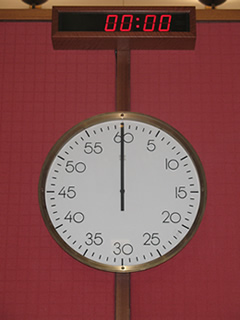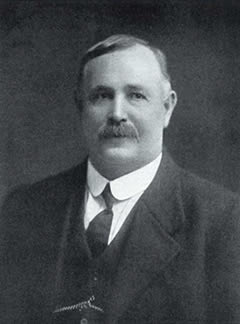189 Time limits on speeches
-
Subject to other time limits specified, a senator shall not speak for more than 20 minutes in any debate in the Senate. A senator may move that that time limit be extended by not more than 10 minutes, and such a motion shall forthwith be put without debate.
-
Where a right of reply is allowed in a debate a senator speaking in reply shall speak for not more than 20 minutes.
-
In committee a senator shall not speak for more than 15 minutes at a time on any question, but where the speech of a senator is interrupted by this provision, and no other senator rises to speak, the senator so interrupted may continue to speak for a further 15 minutes but no longer continuously on a question.
Amendment history
Adopted: 15 August 1919, J.375, as SO 407A
Amended:
- 5 October 1922, J.107 (addition of 30 minute time limit on a reply and provision for limit of two speeches on a question in committee where no other senator rises to speak)
- 22 March 1972, J.918–19 (imposition of 30 minute limit on speeches on broadcast days)
- 20 August 1975, J.860 (also see 19 August 1975, J.853) (reduction of general time limit on speeches to one hour, with a 30 minute extension possible)
- [29 April 1982, J.882–83, also see 27 April 1982, J.865–67 (sessional order adopted for general time limit of 30 minutes, extension of 15 minutes, 30 minutes in reply and 15 minutes on the first reading of a non-amendable bill); re-adopted 22 April 1983, J.37; 22 February 1985, J.36–42; 15 September 1987, J.36–43]
- [25 November 1992, J.3107 (sessional order adopted for 20 minute limit on second reading speeches for remainder of 1992 sittings); re-adopted as amended, 12 May 1993, J.127–130; see also 6 May 1993, J.102; re-adopted on a weekly basis at the beginning of the 38th Parliament]
- 13 February 1997, J.1442–45, J.1447 (to take effect 24 February 1997) (amended version of previous sessional order applying 20 minute limit to debate generally, incorporated in standing orders; relocation of time limit on first reading debate on a non-amendable bill to SO 112 and consequential insertion of proviso at beginning of paragraph (1))
1989 revision: Old SO 407A renumbered as SO 189 and restructured as several paragraphs; sessional order incorporated applying 30 minute general time limit; language modernised and expression streamlined
Commentary

Speaking clocks on the walls of the chamber show the time remaining for a senator's speech. The clocks are operated by the Deputy Clerk at the table (Photo courtesy of Auspic)
No general time limits were adopted in 1903, although they were not unknown elsewhere. It was considered that members of parliament had an important duty to perform and should be unrestricted as to time in putting their case to the legislature. The origin of general time limits can be attributed to Senator Gardiner’s stone-walling in 1918 on the Commonwealth Electoral Bill when he spoke through the night for more than twelve hours,[1] during which he read the entire bill aloud and, as his stamina flagged, was occasionally allowed by the chair to speak while seated.[2]
A few days later, on 4 December 1918, the Leader of the Government in the Senate, Senator Pearce (Nat, WA), moved for the adoption of a new standing order to impose time limits on speeches.[3] An amendment to that motion was agreed to on 10 December 1918, referring the matter to the Standing Orders Committee.[4] Sent away to consider the question, the committee recommended the adoption of the new standing order imposing time limits, as proposed by Senator Pearce. A general time limit of an hour would apply with a possible half hour extension, but one and a half hours would be available on the address-in-reply, on the first reading of a non-amendable bill and for a minister in moving the motion for the second reading of a bill. In committee, a limit of a quarter of an hour would apply with some exceptions and there would be a limit of two speeches per senator on each question (also with some exceptions). [5]
It was a contentious issue. Senator Gardiner (ALP, NSW) alleged, during debate on the motion that the report be printed, that the recommendation had been agreed to only narrowly, on the casting vote of the President (Senator Givens).[6] When the report was debated in committee of the whole a few days later, on 13 August 1919, many senators spoke at length on the proposals, some vehemently opposed and others opposed in principle, even though they thought that shorter speeches would be to everyone’s benefit. Senator O’Loghlin’s (ALP, SA) views were typical of the latter group when he said, “in a deliberative assembly the rights of senators to express their opinions should not be curtailed”.[7] After more than six hours’ debate, the general time limits were adopted, along with the 15 minute time limit in committee, but the latter provision was amended to remove the exceptions and the limitation on speaking more than twice on any question. This limitation was restored, however, when the Standing Orders Committee undertook its comprehensive review in 1922. Also specified was a time limit on speeches in reply.[8]

Senator Albert Gardiner (ALP, NSW) whose 12 hour stonewalling on the Commonwealth Electoral Bill 1918 led directly to the general imposition of time limits on speeched (Source: Commonwealth Parliamentay Handbook)
The current maximum time limit of 20 minutes was first tried at the end of 1992 when a temporary order applying it to second reading speeches on bills was agreed to on 25 November 1992 for the remainder of the year.[9] An election followed early in 1993 and, when the Senate resumed in May, the government proposed that the order be re-adopted. It was hotly debated on 6 and 12 May 1993 and several amendments were moved to moderate its effect:
-
that it not apply when 2 or more bills were taken together (negatived);
-
that the whole matter of appropriate speaking rights be referred to the Procedure Committee (negatived);
-
that the time taken to make and determine points of order or form a quorum not be regarded as part of a senator’s speaking time (agreed to).
The sessional order, as amended, remained in force for the remainder of that government’s term. An important innovation in 1993 was the exclusion of time taken to resolve points of order from a senator’s speaking time, a device borrowed from the orders imposing time limits on asking and answering questions without notice, first agreed to in September 1992.[10] Until then, there had been no explicit authority to “stop the clock” and so preserve shrinking speaking opportunities from potentially mischievous erosion by political opponents. Time taken to form a quorum was also excluded, an idea first raised in a notice of motion in 1989 by Senator McLean (AD, NSW).[11]
With a change of government after the 1996 election, the new government proposed the adoption of a sessional order which extended the application of the 20 minute limit to “debate on any motion” (not just second reading debates). This, too, was hotly debated and not resolved at the time. Instead, the sessional orders in place under the previous government continued in force till the end of that week, and continued to be applied on a week by week basis pending the resolution of certain procedural sticking points (including the allocation of questions without notice, a matter subject to informal arrangements and not covered by the standing orders). The impasse continued till the end of 1996.
In November 1996, the Procedure Committee recommended that sessional orders and orders of continuing effect be incorporated into standing orders in accordance with the draft revision attached to the committee’s report.[12]
The report was considered in February 1997 and the recommendation adopted. At the same time, several other orders, including the more restrictive sessional order applying the 20 minute speech limit to any debate, were agreed to and incorporated into the standing orders. This was dealt with as formal business on 13 February 1997 and agreed to without a division.
From the time of its adoption in 1919 in somewhat colourful circumstances, this standing order has been amended to steadily reduce individual speaking times. The general time limit has been reduced from one hour, to 30 minutes, to 20 minutes, but always with a 50 per cent extension possible. During this time, the size of the Senate has more than doubled and the nature of society has changed dramatically, particularly in relation to information and communications technologies. There are few suggestions nowadays that the speaking times available under the standing orders are not adequate for the needs of senators in a much more hectic world than it was in 1919. Interestingly, the time limit for contributions in committee of the whole has remained constant, reflecting the status of committee of the whole as the legislative workhorse of the Senate.[13]
Other time limits, for example, in relation to motions on documents and reports, are specified in the relevant standing order. See SOs 24A (adoption of Selection of Bills Committee reports), 54 (adjournment), 57(2) (matters of public interest), 61 (government documents), 62 (committee reports, government responses and Auditor-General’s reports), 75 (MPI/Urgency motions), 112(2) (first reading of a non-amendable bill), 115(6) (reference of bills to committee), 169(2) (documents) and 209(4) (suspension of standing orders).
In committee of the whole a senator may speak for up to 15 minutes at a time, but if a senator has spoken for 15 minutes and no other senator rises to speak, that senator may continue to speak for a further 15 minutes. If there is then no other senator who wishes to speak, the senator speaking may not continue on the same question (paragraph (3)). The consequence of this is that at least two senators, speaking in turn, are required to keep debate going on a question in committee of the whole.